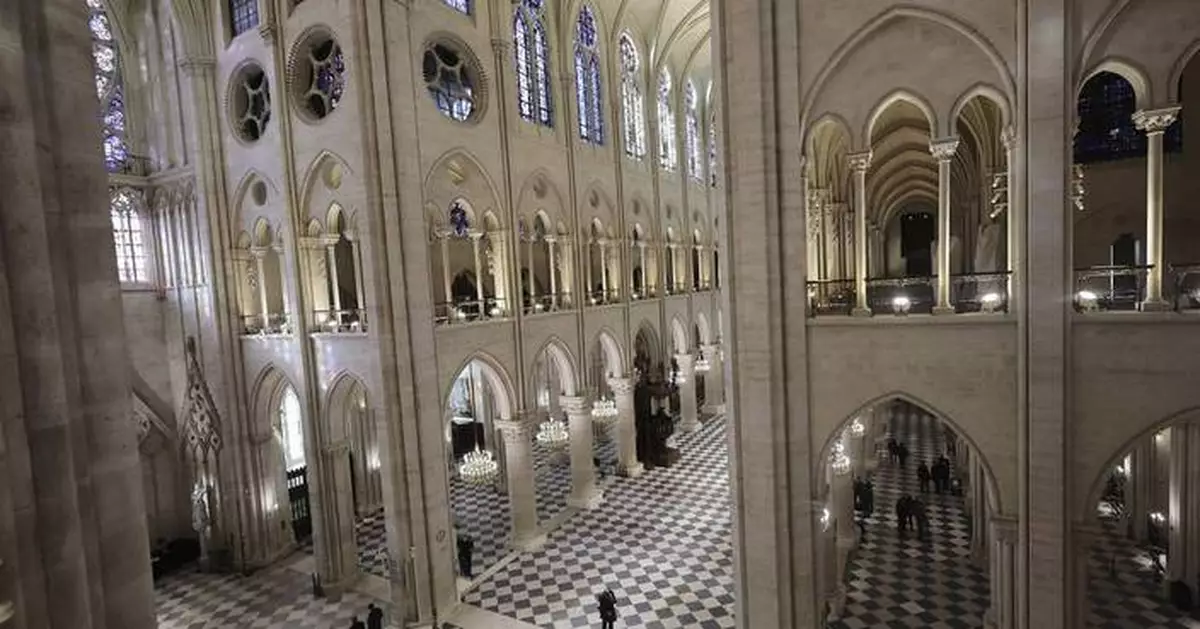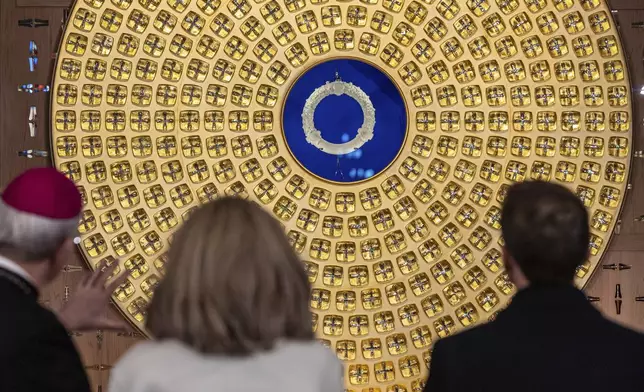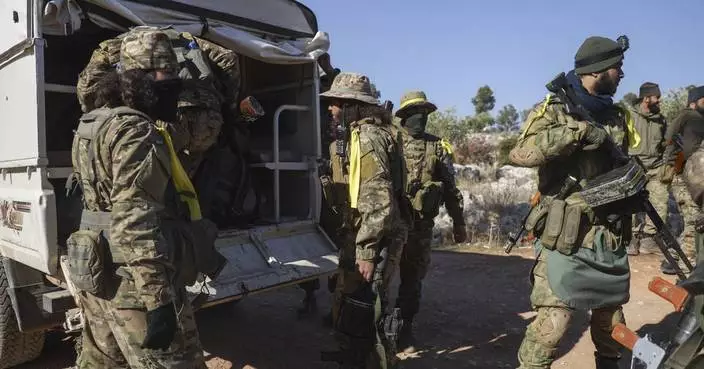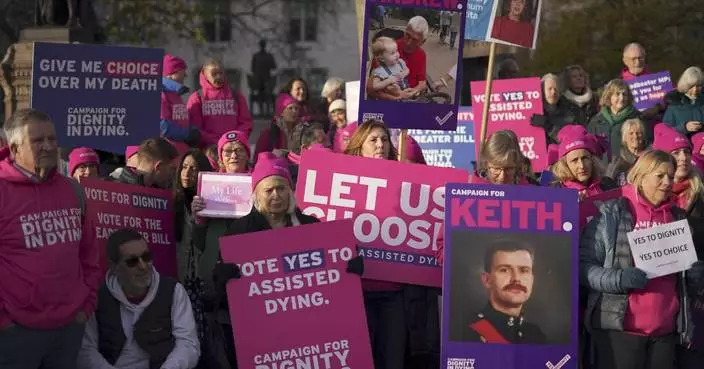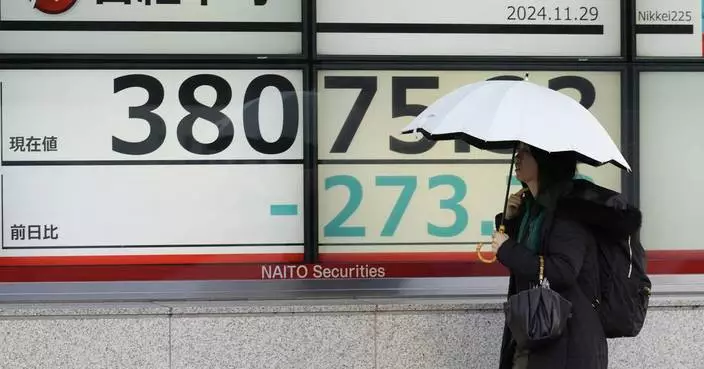PARIS (AP) — Five years after a catastrophic fire reduced Notre Dame Cathedral to a smoldering shell, journalists got a first glimpse of the Gothic masterpiece's fully restored interiors during a visit with French President Emmanuel Macron. The transformation is nothing short of breathtaking: light dances across brilliant stone, gilded accents gleam anew, and the iconic monument's majesty is reborn. From Dec. 8, visitors will once again marvel at the cathedral’s blend of history and craftsmanship.
Here’s a reporter’s-eye view:
Click to Gallery
French President Emmanuel Macron, right, looks at the reliquary of the Crown of Thorns designed by French Artist Sylvain Dubuisson as he visits the restored interiors of the Notre-Dame de Paris cathedral, Friday, Nov. 29, 2024 in Paris. (Christophe Petit Tesson/Pool via AP)
French President Emmanuel Macron delivers a speech to construction workers inside the Notre-Dame de Paris cathedral after visiting the restored interiors of the monument, Friday, Nov. 29, 2024 in Paris. (Sarah Meyssonnier/Pool via AP)
The reliquary of the Crown of Thorns, designed by French Artist Sylvain Dubuisson, is seen in the Notre-Dame de Paris cathedral, Friday, Nov. 29, 2024 in Paris. (Christophe Petit Tesson/Pool via AP)
French President Emmanuel Macron, center, and his wife Brigitte Macron, second right, visit the restored interiors of the Notre-Dame de Paris cathedral, Friday, Nov. 29, 2024 in Paris. (Christophe Petit Tesson/Pool via AP)
FILE - A hole is seen in the dome inside Notre Dame cathedral after the fire in Paris, Tuesday, April 16, 2019. (Christophe Petit Tesson, Pool via AP, File)
France's anti-terror Sentinelle operation soldiers patrol as French President Emmanuel Macron visits the renovated Notre Dame Cathedral in Paris, Friday, Nov. 29, 2024. (AP Photo/Louise Delmotte)
People stand inside Notre-Dame Cathedral in Paris, Friday Nov. 29 2024 before French President Emmanuel Macron's final visit to the construction site to see the restored interiors before the iconic monument's reopening for worship on Dec. 8. (Sarah Meyssonnier, Pool via AP)
The baptistery designed by French artist and designer Guillaume Bardet is seen at Notre-Dame de Paris cathedral while French President Emmanuel Macron visits the restored interiors of the monument, Friday Nov. 29, 2024, in Paris. (Stephane de Sakutin, Pool via AP)
French President Emmanuel Macron, second right, and his wife Brigitte Macron visit the restored interiors of the Notre-Dame de Paris cathedral, Friday, Nov. 29, 2024 in Paris. (Sarah Meyssonnier/Pool via AP)
Construction workers who took part to the Notre-Dame cathedral restoration visit the cathedral after French President Emmanuel Macron's visit of the restored interiors, Friday, Nov.29, 2024 in Paris. (Christophe Petit Tesson, Pool via AP)
Windows in the heart of Notre-Dame de Paris cathedral are seen while French President Emmanuel Macron visits the restored interiors of the monument, Friday Nov. 29, 2024, in Paris. (Stephane de Sakutin, Pool via AP)
The choir stalls of Notre-Dame de Paris cathedral are seen while French President Emmanuel Macron visits the restored interiors of the monument, Friday Nov. 29, 2024, in Paris. (Stephane de Sakutin, Pool via AP)
People stroll in Notre-Dame de Paris cathedral while French President Emmanuel Macron visits the restored interiors the monument, Friday, Nov.29, 2024 in Paris. (Christophe Petit Tesson, Pool via AP)
The nave, once darkened by soot and rubble, now radiates a celestial brilliance. Visitors can see the true color of the cathedral’s walls: a pale Lutetian limestone — named after the Roman word for Paris, Lutecia — that glows under sunlight streaming through restored stained-glass windows. The newfound blond hues highlight the soaring Gothic columns and ribbed vaults, creating a bright and uplifting atmosphere. Restorers say it's the first time in centuries the true stone has been exposed in this way.
The polished checkerboard marble floor, glistening underfoot, is so smooth it seems you could glide across it — communicating with the gilded, golden grille partition of the choir area.
Overhead, incandescent chandeliers hang majestically from each vaulted arch, stretching from west to east, casting a warm, golden light throughout the nave.
The meticulous restoration process involved cleaning over 42,000 square meters of stone — an area equivalent to roughly six soccer fields — using innovative latex peels to strip away centuries of grime without causing damage. Conservators uncovered mason marks etched by medieval builders — intimate traces of the artisans who shaped Notre Dame in the 12th and 13th centuries.
This gleaming transformation is a stark contrast to the wreckage of 2019, when the nave was strewn with charred debris.
The altar in the cathedral’s chancel carries a poignant symbol of the fire’s devastation. Nicolas Coustou’s Pietà, part of the Vœu de Louis XIII ensemble, survived largely unscathed, but molten lead from the blaze fused into the hand of Christ. Restorers chose to preserve this as a subtle, yet powerful, reminder of the tragedy.
Surrounding the altar, the intricate marquetry floor, long hidden under layers of dirt, has been pieced together from fragments recovered after the fire.
Nearby, the polished Cross of Glory, which famously — literally — glowed amid the flames, now stands restored to its full brilliance. Framed by the radiant blonde stonework of the nave, the cross serves as a centerpiece of the cathedral’s rebirth.
The grand organ, among the largest and most storied in France, has undergone an intricate revival. Spared from the flames but coated in lead dust, its 8,000 pipes, ranging in size from that of a pen to over 10 meters (33 feet) tall, were painstakingly disassembled, cleaned, and retuned. Over two years, this work was performed with precision in the cathedral’s silent, cavernous interior, where harmonization was achieved entirely by ear.
Now, the organ’s grandeur is unmistakable. Its towering wooden case, marked with carvings left by past craftsmen, gleams under sunlight streaming through restored clerestory windows. Even in silence, it commands awe.
The 29 chapels circling the nave and choir burst with color and detail previously dulled by dirt and neglect. Restorers revealed intricate murals, gilded stars on ceilings, and vibrant motifs originally created under Eugène Viollet-le-Duc’s direction. Each chapel tells a unique story through its designs and themes.
The Chapel of Saint Marcel stands out as a masterpiece, its mural of the saint’s relics vividly restored. Visitors are captivated by its radiant colors, producing an effect likened to the Sistine Chapel in Rome — a visual firework display. In other chapels, traces of 19th-century painters’ color tests, hidden in nooks, provide glimpses into their artistic process.
The transept crossing, where the original spire collapsed, presented one of the restoration’s most formidable challenges. Above, soaring new vaults of Lutetian limestone replicate the medieval originals with remarkable precision.
Beneath the crossing, archaeologists uncovered a trove of history: fragments of Notre Dame’s medieval jubé, or choir screen, buried in the rubble. These intricately carved stones, some still bearing faint traces of polychrome paint, provide a rare glimpse into the cathedral’s vibrant 13th-century decorative history.
The newly restored roof draw gazes skyward, where medieval timber techniques have been faithfully recreated. Known as “the forest,” the intricate wooden framework remains hidden beneath the roofline, but glimpses into the rafters reveal the precision of both ancient and modern craftsmanship.
Outside, the spire rises 96 meters, faithfully replicating Viollet-le-Duc’s 19th-century design. Clad in oak and lead, it stands crowned by a gilded rooster containing relics of St. Denis, St. Genevieve, and a fragment of the Crown of Thorns, alongside a scroll listing contributors to the restoration.
The spire also honors the late General Jean-Louis Georgelin, who oversaw the project until his death in 2023. His name is now etched at its base.
There’s more than meets the eye in this restoration. Notre Dame now features unseen state-of-the-art fire prevention systems to guard against future disasters. Thermal cameras monitor the roof, and a fine misting system, designed to extinguish flames at their source, is seamlessly integrated into the structure. Fireproof barriers divide the roof into compartments, preventing flames from spreading.
Reinforced water supply lines can deliver 600 cubic meters (21,188 cubic feet) of water per hour, ensuring the cathedral is better protected than ever before.
For more of AP's coverage on Notre Dame, visit https://apnews.com/hub/notre-dame-cathedral

French President Emmanuel Macron, right, looks at the reliquary of the Crown of Thorns designed by French Artist Sylvain Dubuisson as he visits the restored interiors of the Notre-Dame de Paris cathedral, Friday, Nov. 29, 2024 in Paris. (Christophe Petit Tesson/Pool via AP)
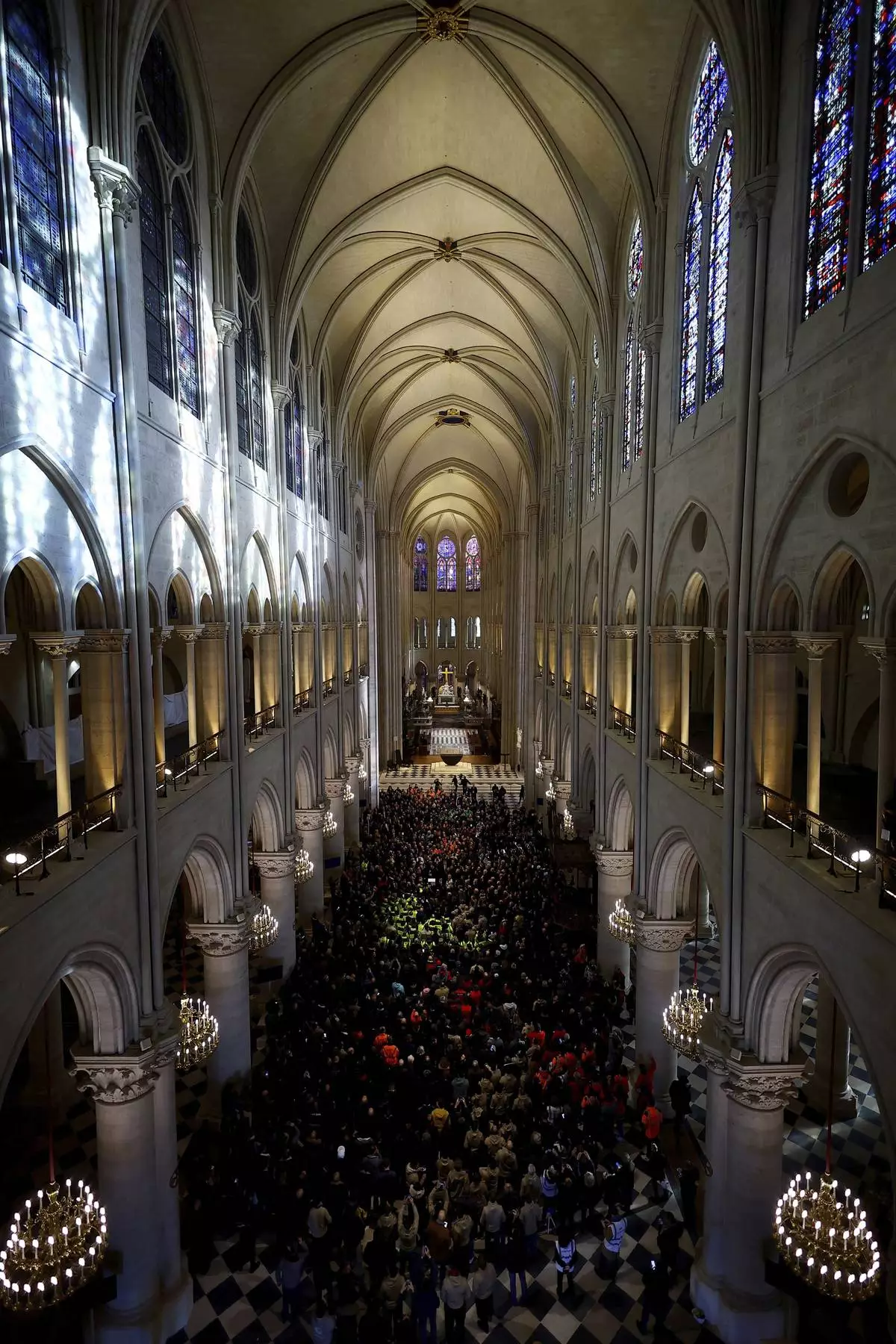
French President Emmanuel Macron delivers a speech to construction workers inside the Notre-Dame de Paris cathedral after visiting the restored interiors of the monument, Friday, Nov. 29, 2024 in Paris. (Sarah Meyssonnier/Pool via AP)
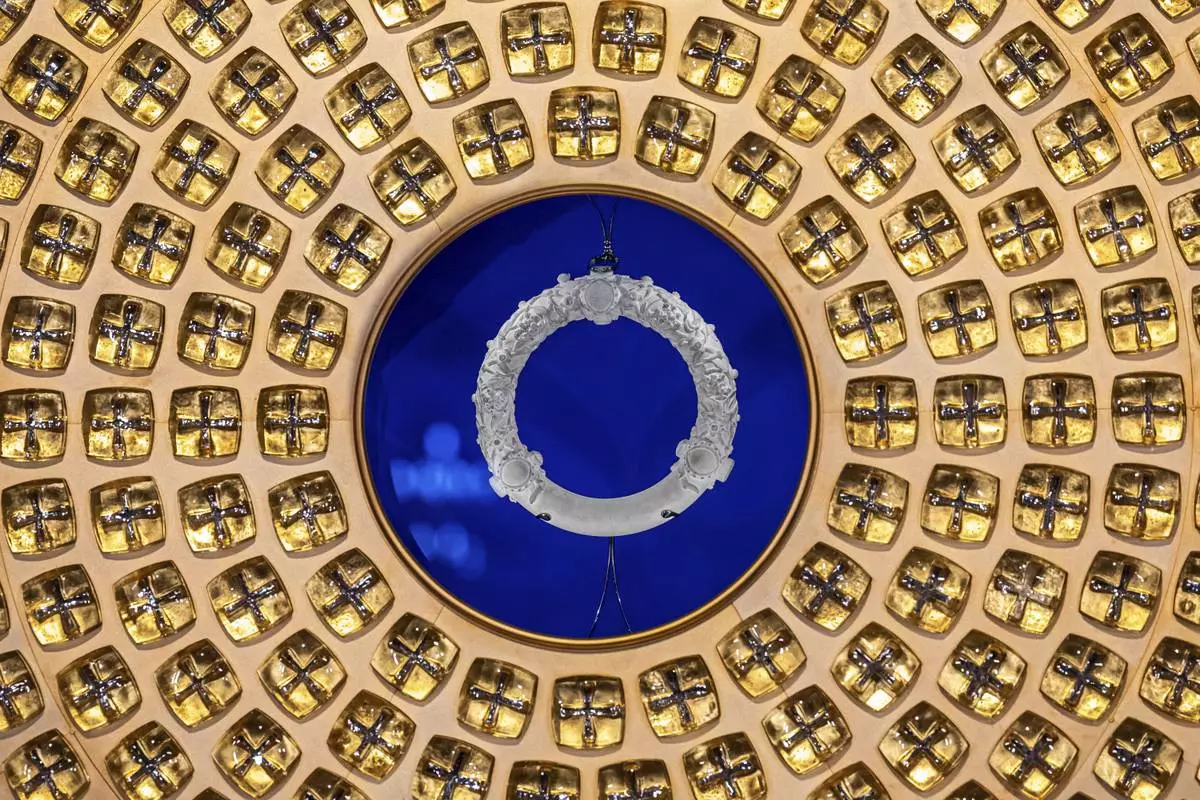
The reliquary of the Crown of Thorns, designed by French Artist Sylvain Dubuisson, is seen in the Notre-Dame de Paris cathedral, Friday, Nov. 29, 2024 in Paris. (Christophe Petit Tesson/Pool via AP)
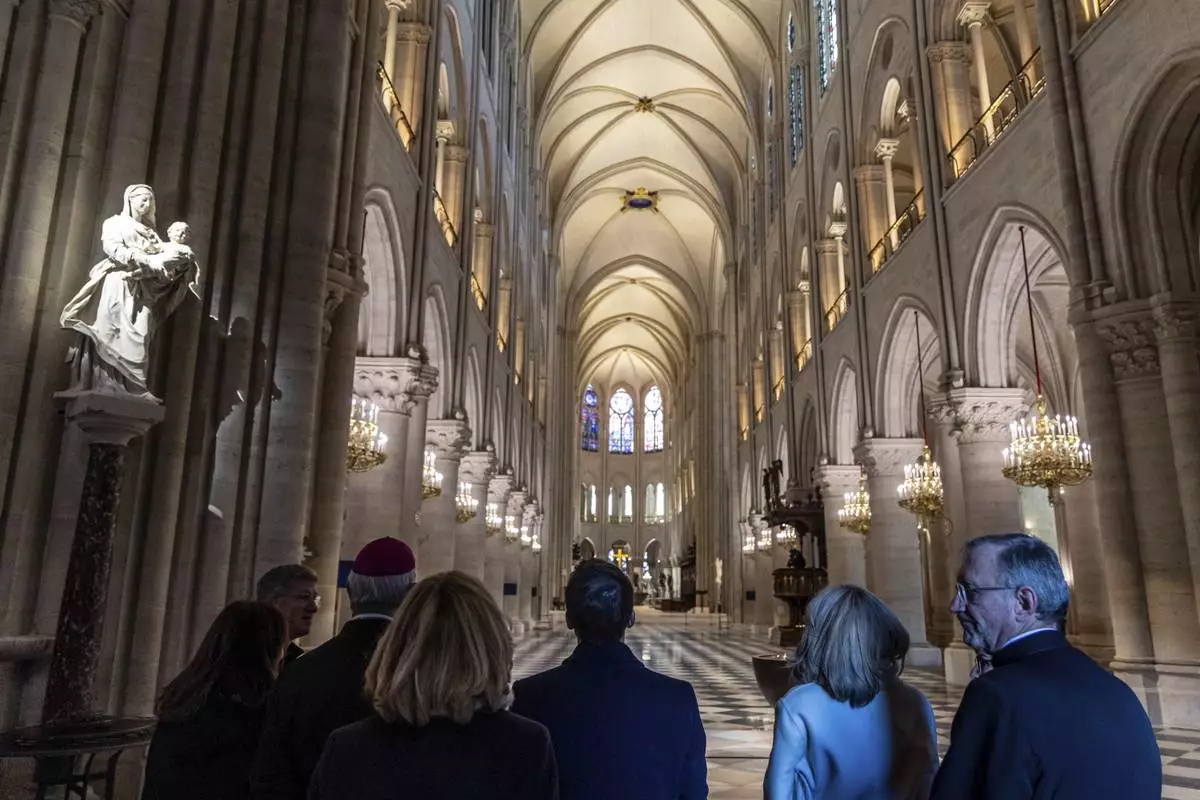
French President Emmanuel Macron, center, and his wife Brigitte Macron, second right, visit the restored interiors of the Notre-Dame de Paris cathedral, Friday, Nov. 29, 2024 in Paris. (Christophe Petit Tesson/Pool via AP)
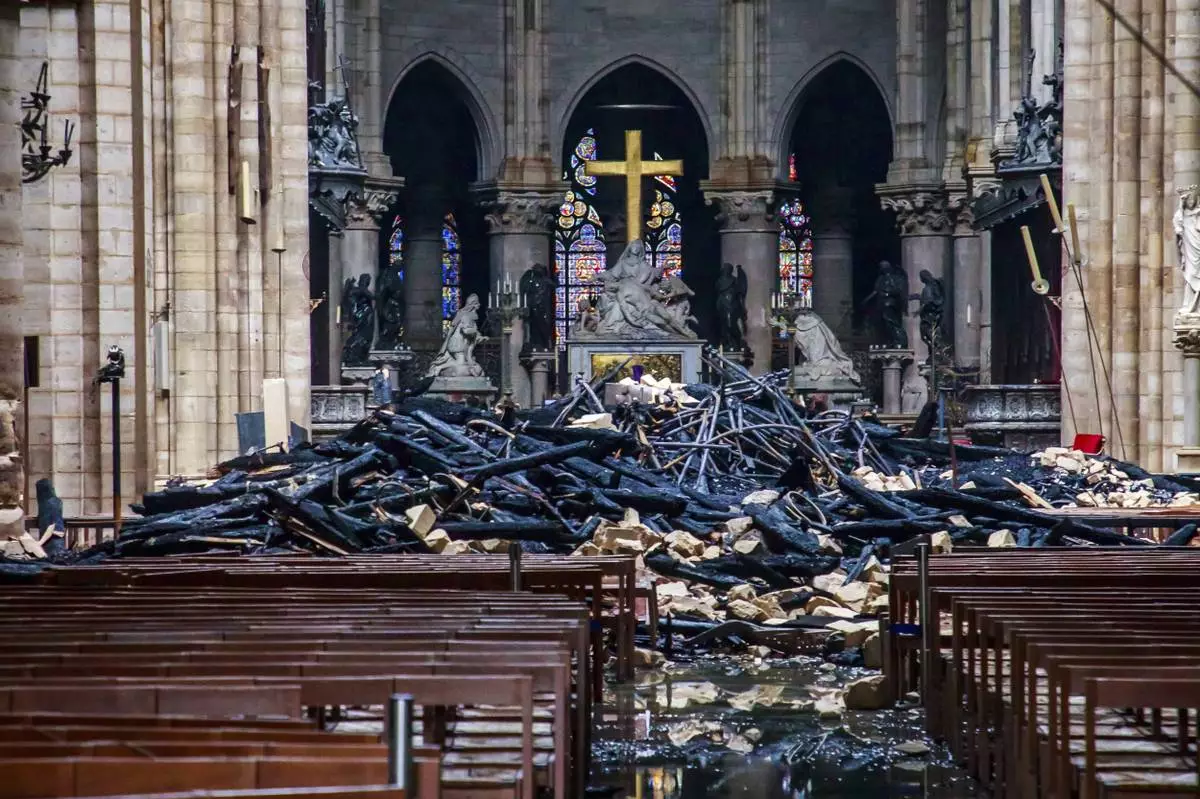
FILE - A hole is seen in the dome inside Notre Dame cathedral after the fire in Paris, Tuesday, April 16, 2019. (Christophe Petit Tesson, Pool via AP, File)
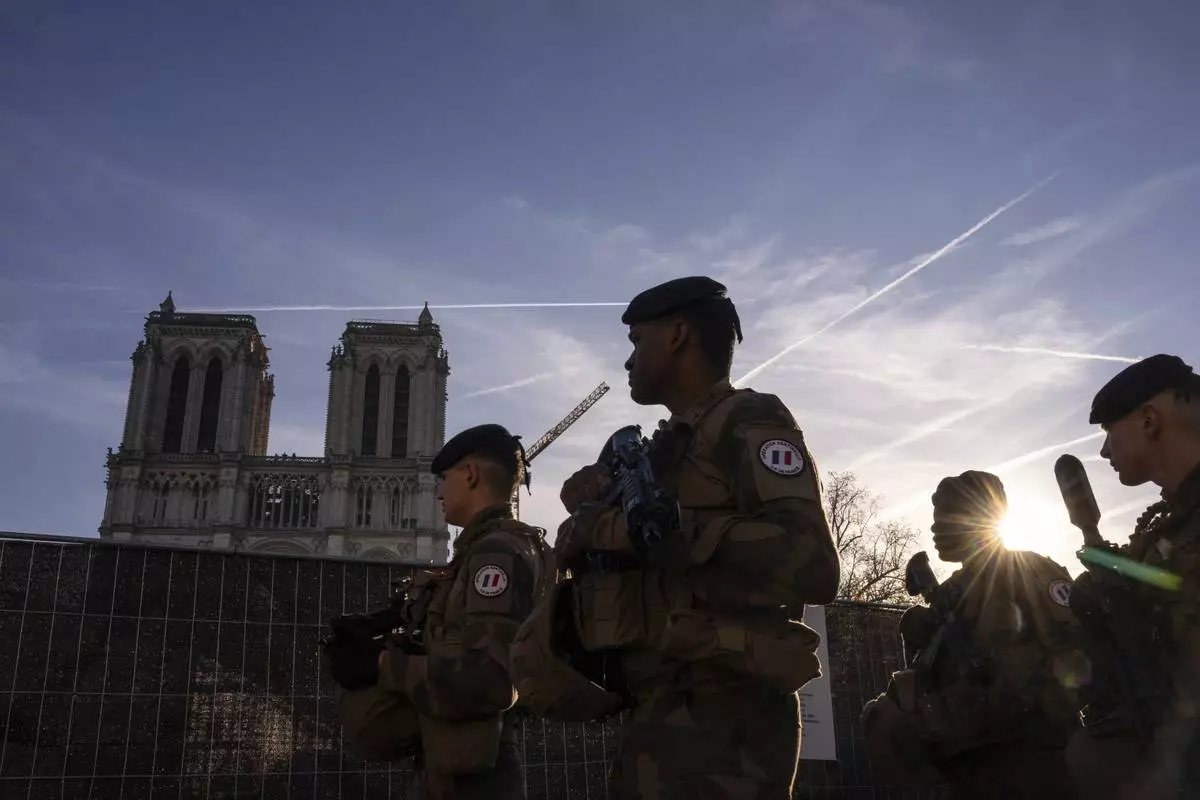
France's anti-terror Sentinelle operation soldiers patrol as French President Emmanuel Macron visits the renovated Notre Dame Cathedral in Paris, Friday, Nov. 29, 2024. (AP Photo/Louise Delmotte)
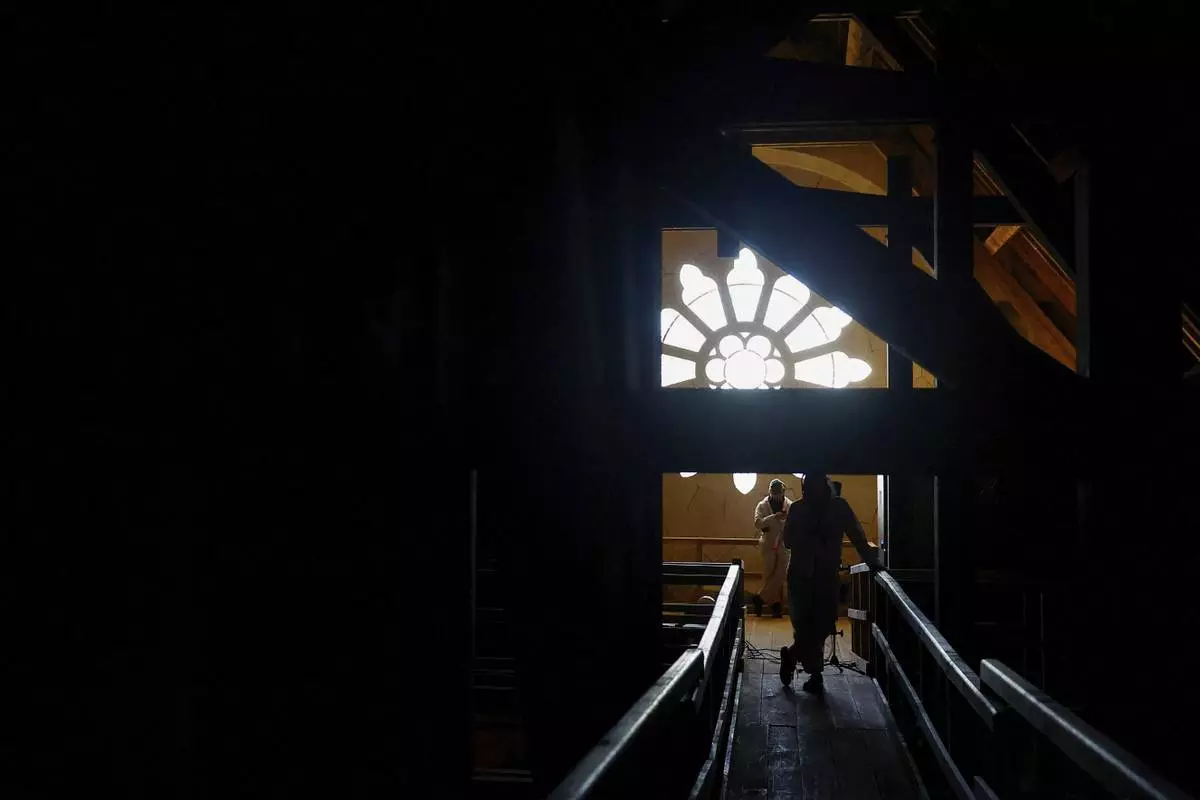
People stand inside Notre-Dame Cathedral in Paris, Friday Nov. 29 2024 before French President Emmanuel Macron's final visit to the construction site to see the restored interiors before the iconic monument's reopening for worship on Dec. 8. (Sarah Meyssonnier, Pool via AP)
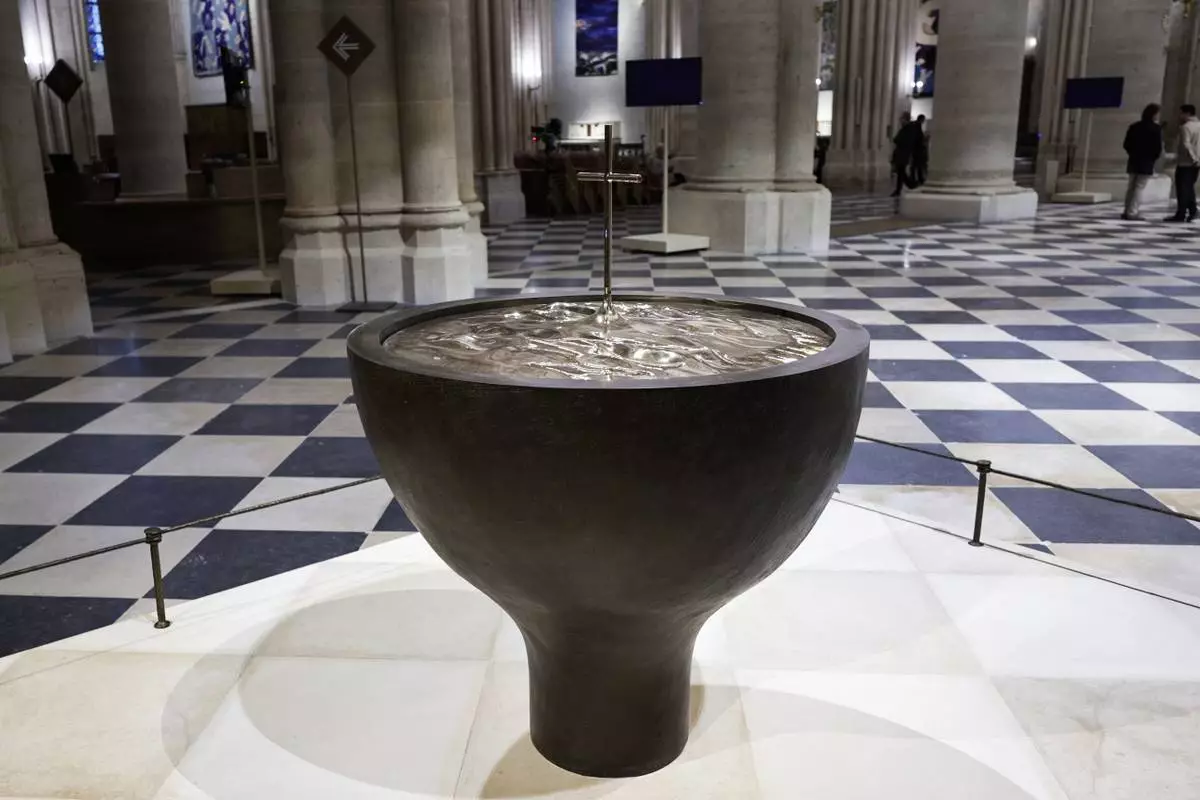
The baptistery designed by French artist and designer Guillaume Bardet is seen at Notre-Dame de Paris cathedral while French President Emmanuel Macron visits the restored interiors of the monument, Friday Nov. 29, 2024, in Paris. (Stephane de Sakutin, Pool via AP)

French President Emmanuel Macron, second right, and his wife Brigitte Macron visit the restored interiors of the Notre-Dame de Paris cathedral, Friday, Nov. 29, 2024 in Paris. (Sarah Meyssonnier/Pool via AP)
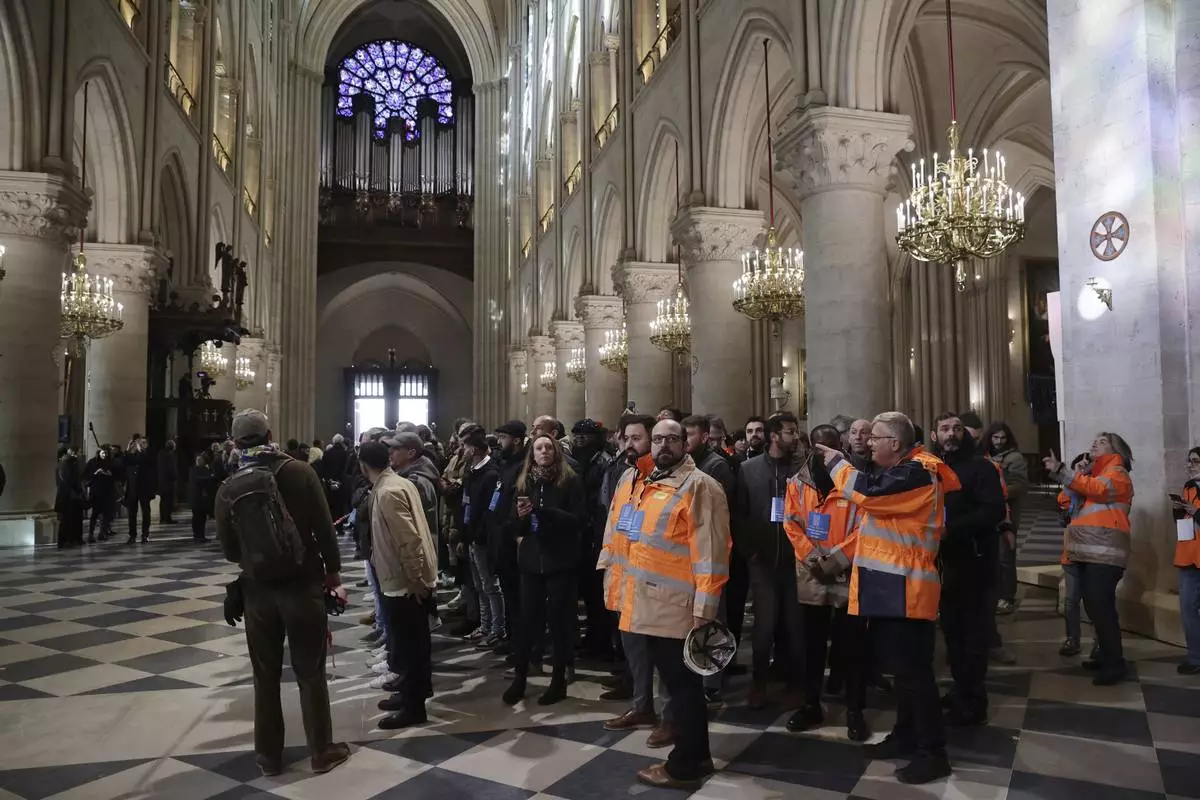
Construction workers who took part to the Notre-Dame cathedral restoration visit the cathedral after French President Emmanuel Macron's visit of the restored interiors, Friday, Nov.29, 2024 in Paris. (Christophe Petit Tesson, Pool via AP)
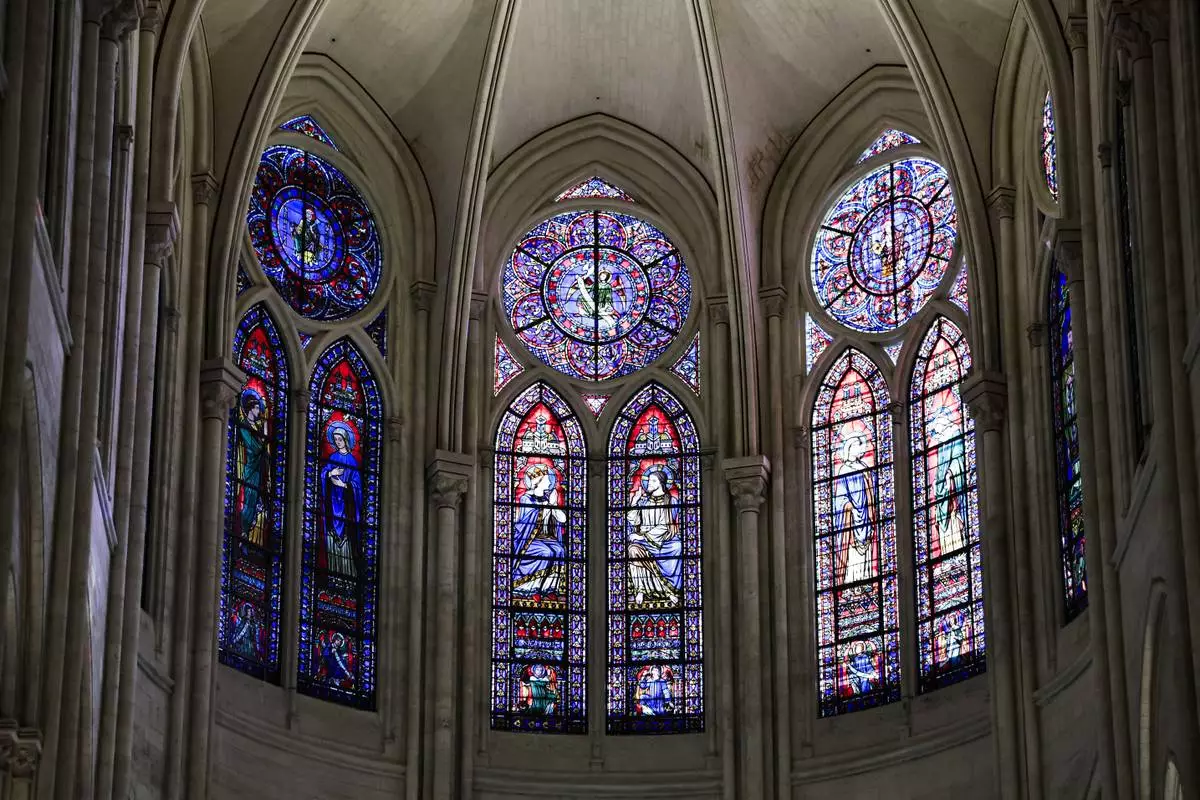
Windows in the heart of Notre-Dame de Paris cathedral are seen while French President Emmanuel Macron visits the restored interiors of the monument, Friday Nov. 29, 2024, in Paris. (Stephane de Sakutin, Pool via AP)
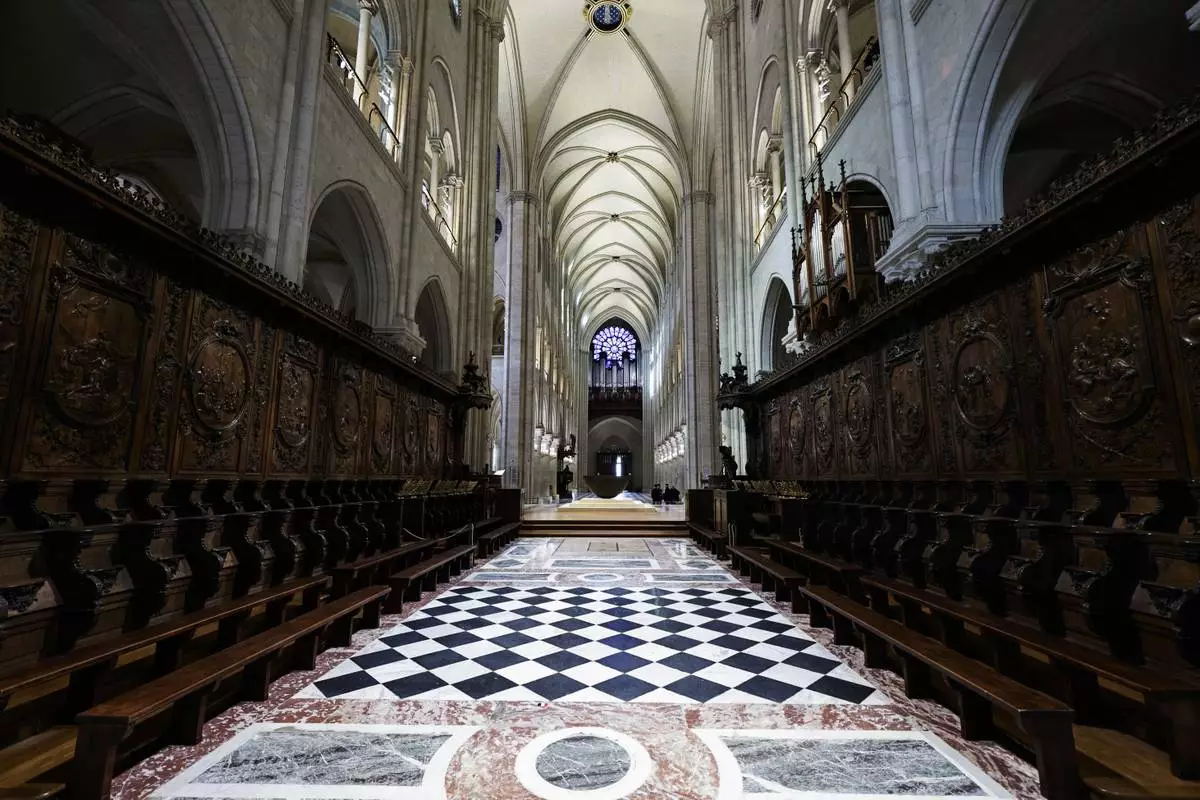
The choir stalls of Notre-Dame de Paris cathedral are seen while French President Emmanuel Macron visits the restored interiors of the monument, Friday Nov. 29, 2024, in Paris. (Stephane de Sakutin, Pool via AP)
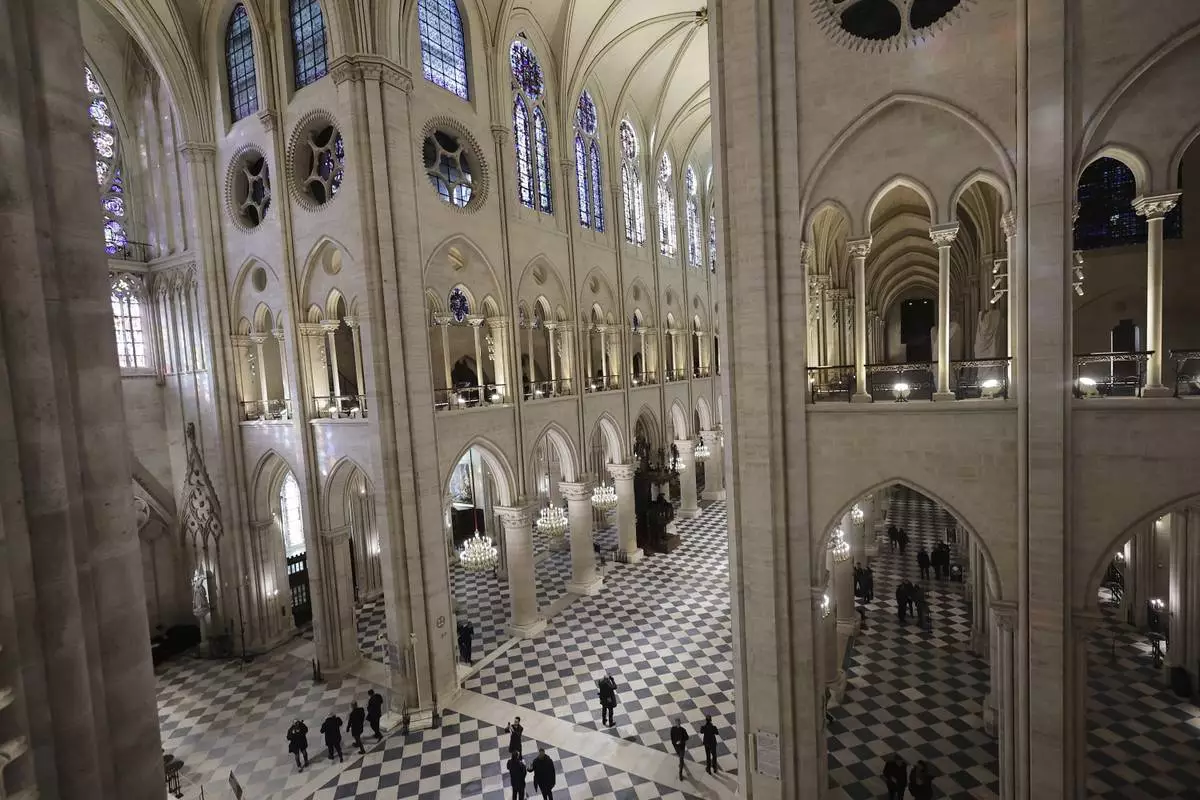
People stroll in Notre-Dame de Paris cathedral while French President Emmanuel Macron visits the restored interiors the monument, Friday, Nov.29, 2024 in Paris. (Christophe Petit Tesson, Pool via AP)
Two children and a woman were crushed to death Friday as a crowd of Palestinians pushed to get bread at a bakery in the Gaza Strip amid a worsening food crisis in the war-ravaged territory, medical officials said.
The bodies of two girls aged 13 and 17 and the 50-year-old woman were taken to the Al-Aqsa Martyrs Hospital in Deir al-Balah in central Gaza, where a doctor confirmed that they died from suffocation due to crowding at the al-Banna bakery. Video from The Associated Press showed their bodies placed next to each other on the floor inside the hospital's morgue.
The flow of food allowed into Gaza by Israel has fallen to nearly its lowest level of almost 14-month-old war for the past two months, according to Israeli official figures. U.N. and aid officials say hunger and desperation are growing among Gaza’s population, almost all of which relies on humanitarian aid to survive.
Osama Abu Laban, the father of one of the girls, wailed over the loss of her life outside the hospital.
“My wife fell when she heard that she (our daughter) was suffocating. She did not yet know that she was dead,” he told the AP.
Some bakeries in Gaza were closed for several days last week due to a shortage of flour. AP footage taken last week after they reopened showed large crowds of people cramming together, screaming and pushing, at one bakery in Deir al-Balah.
Palestinians across the Gaza Strip are heavily relying on bakeries and charitable kitchens, with many able to only secure one meal a day for their families.
In Lebanon, thousands of displaced people began returning to their homes this week after a ceasefire was announced between Israel and the Hezbollah militant group.
Many found their homes reduced to rubble after intense Israeli airstrikes over the past two months leveled entire neighborhoods in eastern and southern Lebanon, as well as the southern suburbs of Beirut. Nearly 1.2 million people have been displaced.
The truce was the first major sign of progress in the region since war began more than a year ago, triggered by Hamas’ attack on Israel on Oct. 7, 2023. But it does not address the devastating war in Gaza. For Palestinians in Gaza and families of hostages held in the territory, the ceasefire marked another missed opportunity to end fighting that has stretched on for nearly 14 months.
More than 44,000 people have been killed and more than 104,000 wounded, according to Gaza’s Health Ministry. Israel has destroyed large parts of Gaza and displaced nearly all of its 2.3 million people.
Here's the Latest:
JERUSALEM — Israel’s military said it struck an area in southern Lebanon where it detected movement of a Hezbollah rocket launcher on Friday, the third day of the ceasefire between Hezbollah and Israel.
In the statement on the airstrike, the military said it would “actively enforce violations of the ceasefire agreement.”
The strike followed several Israeli military attacks in southern Lebanon earlier in the day, which were reported by the Lebanese state media, and an Israeli drone strike on a Hezbollah weapons depot on Thursday.
There was no immediate comment from the Lebanese army, which has accused Israel of breaking the ceasefire several times since it came into effect.
RAMALLAH, West Bank — Hamas claimed responsibility for a shooting attack on an Israeli bus in the occupied West Bank on Friday that wounded eight people, including four soldiers.
It was the latest violence to scar the territory as tensions run high 14 months into the Israel-Hamas war.
The attacker, who Hamas identified in a statement as Samer Hussein, 46, was killed by Israeli troops shortly after opening fire toward the bus at a junction near the Israeli settlement of Ariel.
The military said four soldiers were lightly wounded. Paramedics said three people were critically wounded.
Attacks by Palestinian militants on Israelis in the volatile territory have grown more common since the start of the Israel-Hamas war, as Palestinian deaths have also spiked. Israeli fire has killed 796 Palestinians since Oct. 7, 2023, mostly in military raids on Palestinian cities and towns. Attacks by settlers on Palestinians and their property have also increased.
BEIRUT — The Israeli army carried out several attacks in southern Lebanon on Friday, the third day of the ceasefire between Hezbollah and Israel, Lebanon’s state media said.
Artillery bombardment struck the villages of Markaba, Talusa and Khiyam while four Israeli tanks moved into the western part of Khiyam, the report said, adding that an Israeli tank fired at a house in Nabatiyeh province.
Local media also reported that the Israeli army fired on civilians in the nearby village of Bint Jbeil. No casualties were immediately reported and The Associated Press was not immediately able to verify the claims.
Israel's and Lebanon's armies did not comment on the alleged attacks.
BEIRUT — The leader of a leading Christian political party in Lebanon has called on Hezbollah to engage with the Lebanese army and devise a plan to dismantle its military infrastructure south and north of the Litani river.
In a press conference Friday, Samir Geagea, head of the Lebanese Forces Party, criticized Hezbollah for opening a front with Israel and accused the Shiite militant group of committing a “major crime” against the Lebanese people.
“We could have done without the martyrdom of more than 4,000 people, the displacement of thousands and the destruction across the country,” Geagea said. “Despite all these tragedies, Hezbollah continues to talk about a victory using a bizarre and disconnected logic that has no basis in reality.”
Geagea’s comments came two days after a U.S.-brokered ceasefire between Hezbollah and Israel went into effect. More than 3,900 people have been killed in Lebanon since Israel's conflict with Hezbollah escalated.
Geagea, whose Lebanese Forces Party holds the largest bloc in Lebanon’s 128-member parliament, also addressed Lebanon’s presidential deadlock. The country has been without a president for more than two years.
Parliament Speaker Nabih Berri has scheduled a session for presidential elections in January. "Consultations with opposition factions and our allies will begin in the coming days to explore the possibility of agreeing on presidential candidates and bringing them to parliament,” Geagea said.
Two children and a 50-year-old woman were crushed to death Friday as a crowd of Palestinians pushed to get bread at a bakery in the central Gaza town of Deir al-Balah, medical officials said.
The flow of food allowed into Gaza by Israel has fallen to nearly its lowest level of the almost 14-month-old war for the past two months, according to Israeli official figures. U.N. and aid officials say hunger and desperation are growing among Gaza’s population, almost all of which relies on humanitarian aid to survive.
A doctor at Al-Aqsa Hospital confirmed that the three died from suffocation due to crowding at the al-Banna bakery in Deir al-Balah.
Some bakeries in Gaza were closed for several days last week due to a shortage of flour. AP footage taken last week after they reopened showed large crowds of people cramming together, screaming and pushing, at one bakery in Deir al-Balah. Bags of bread now sell in the black market near bakeries for up to $17 each.
Palestinians across the Gaza Strip are heavily relying on bakeries and charitable kitchens, with many able to only secure one meal a day for their families.
Osama Abu Laban, the father of one of the girls killed Friday, wailed over the loss of her life outside the hospital.
“My wife fell when she heard that she (our daughter) was suffocating. She did not yet know that she was dead,” he told the AP. He added that he had also lost his son, father, uncle, and cousins, all in northern Gaza.
Several women gathered inside the morgue to mourn their dead relatives, with one woman screaming “they went to buy bread, they crushed them.”
Read more of the AP's coverage of the Middle East wars:
https://apnews.com/hub/mideast-wars
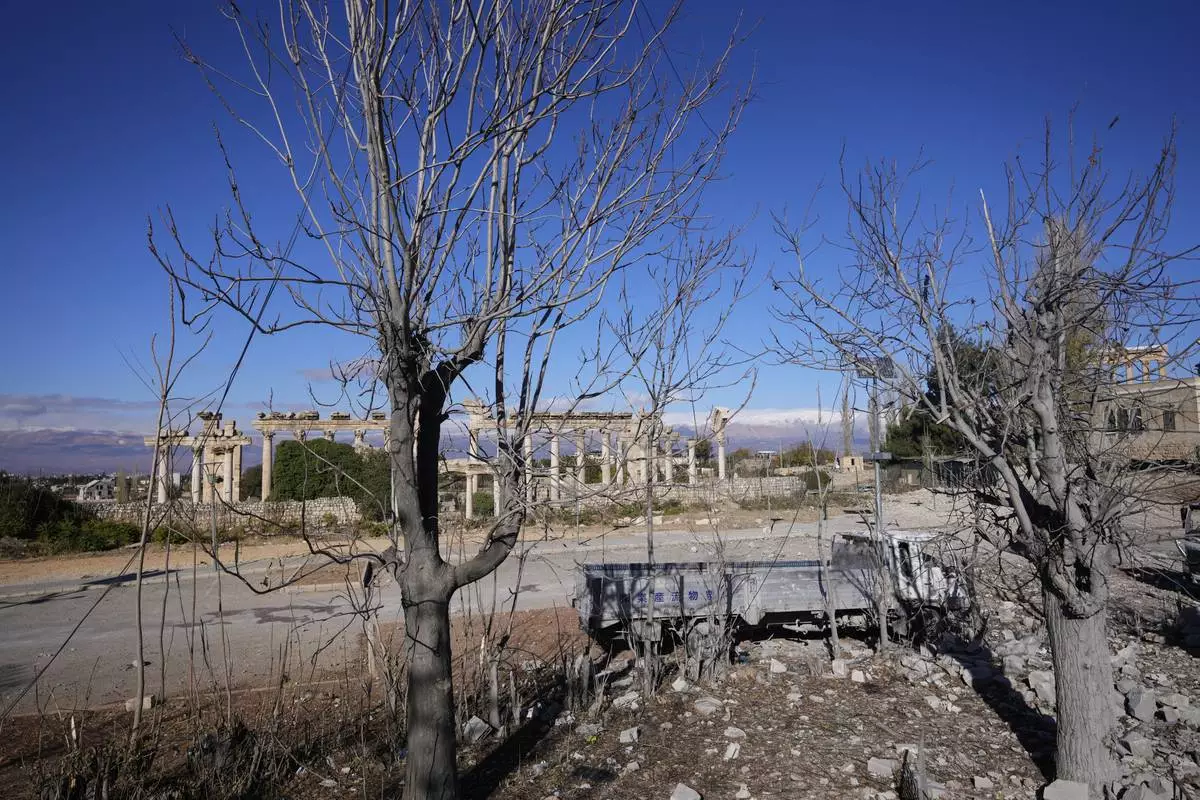
Damaged vehicles are seen in front of the Roman temples of Baalbek in eastern Lebanon, Thursday, Nov. 28, 2024. (AP Photo/Hassan Ammar)

Displaced residents return to Dahiyeh, in Beirut, Lebanon, following a ceasefire between Israel and Hezbollah that went into effect, Nov. 27, 2024. (AP Photo/Bilal Hussein)
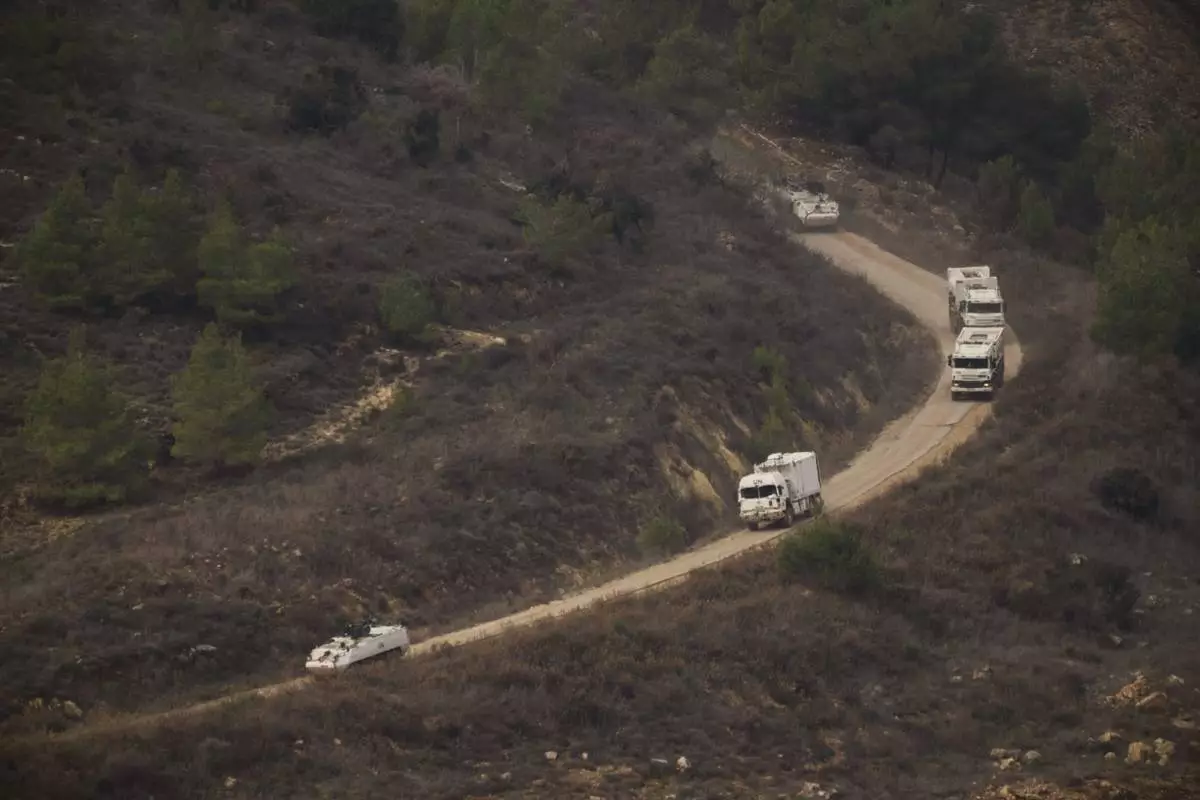
A convoy of the United Nations peacekeeping forces in Lebanon (UNIFIL) drives on area along the Israeli-Lebanese border as seen from northern Israel, Friday, Nov. 29, 2024. (AP Photo/Leo Correa)
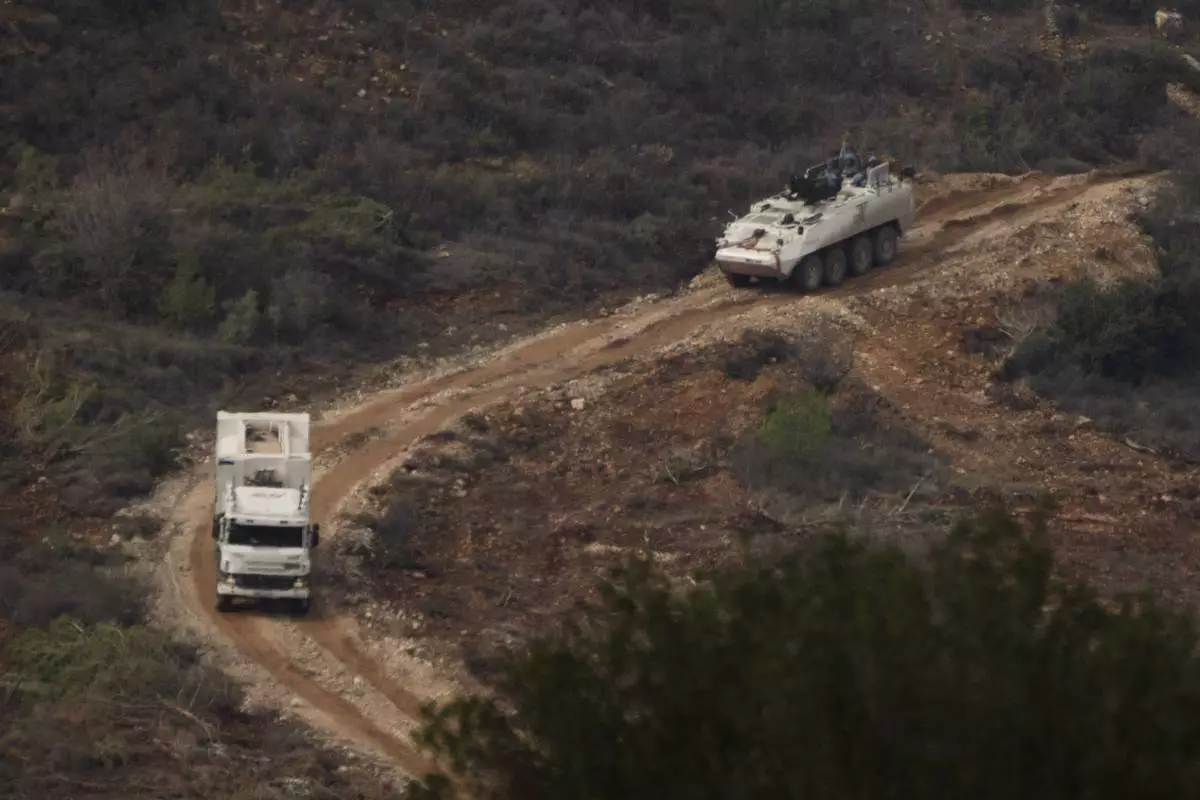
A convoy of the United Nations peacekeeping forces in Lebanon (UNIFIL) drives on area along the Israeli-Lebanese border as seen from northern Israel, Friday, Nov. 29, 2024. (AP Photo/Leo Correa)
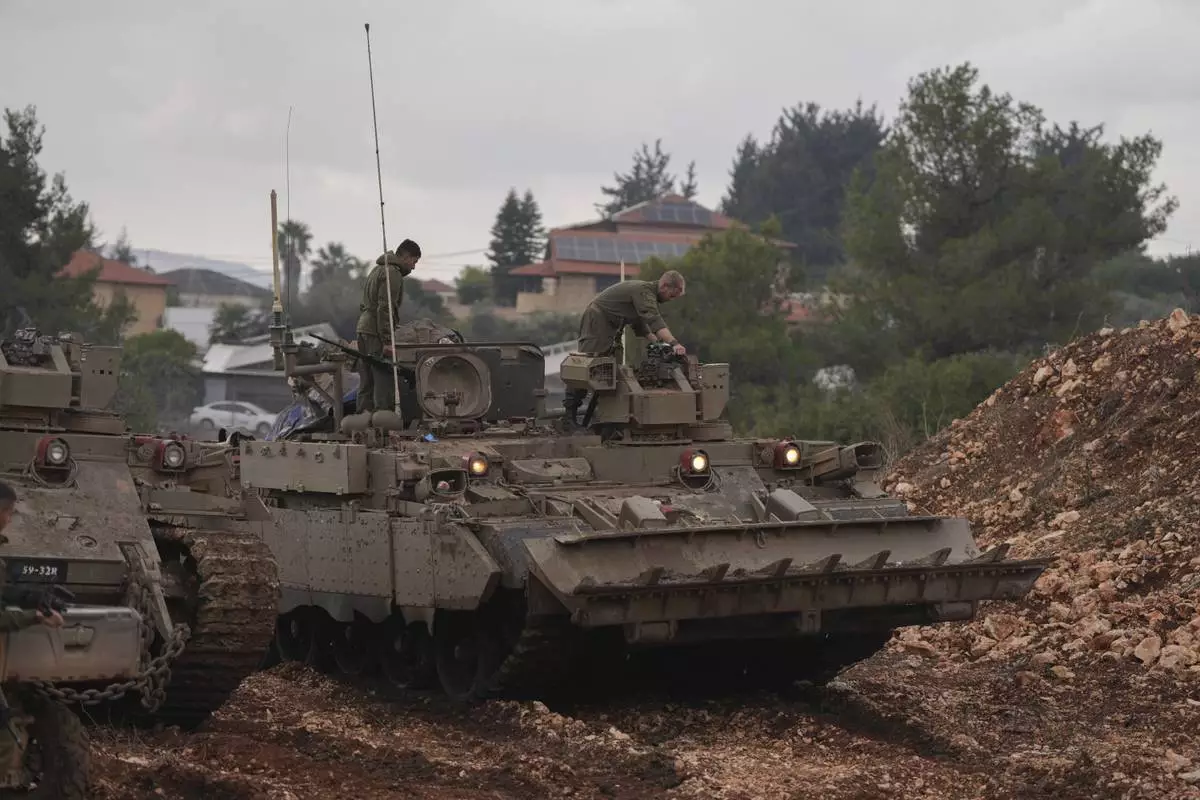
Israeli soldiers stand atop army armoured vehicles outside the agricultural settlement of Avivim, next to the Lebanese border in upper Galilee, Israel, Thursday Nov 28, 2024. (AP Photo/Ohad Zwigenberg)
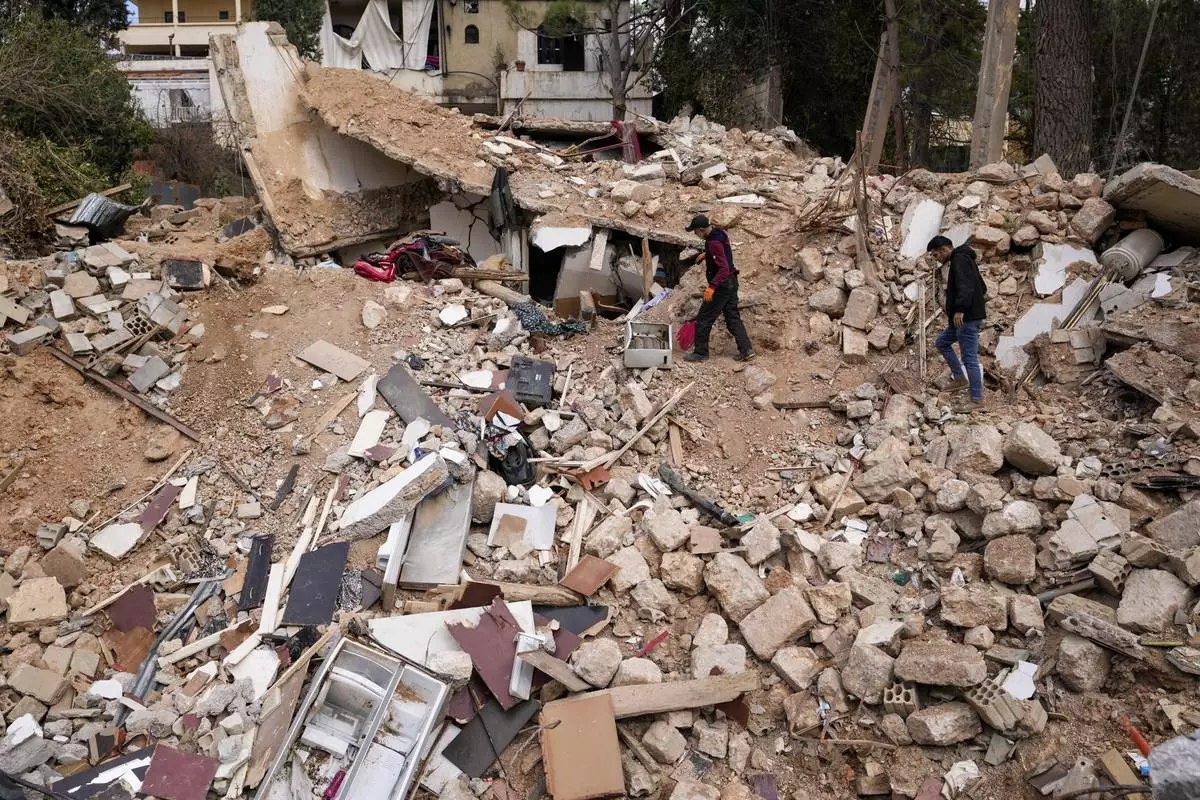
Displaced residents walk on the rubble of their destroyed house in Baalbek, eastern Lebanon, Thursday, Nov. 28, 2024. (AP Photo/Hassan Ammar)















